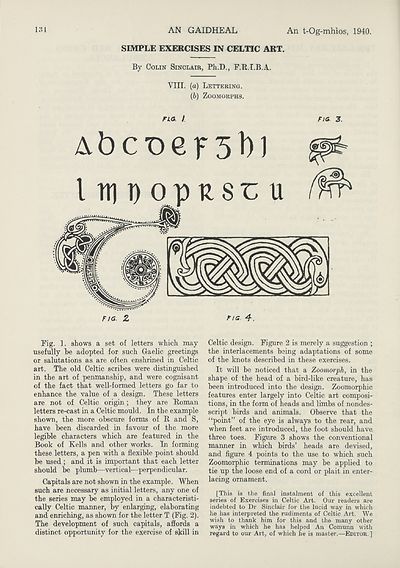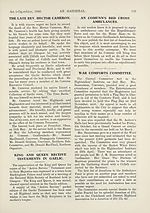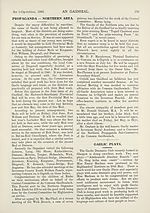An Comunn Gàidhealach Publications > Gaidheal > Volume 35, October 1939--September 1940
(142) Page 134
Download files
Complete book:
Individual page:
Thumbnail gallery: Grid view | List view

AN GAIDHEAL
An t-Og-mhios, 1940.
i:u
SIMPLE EXERCISES IN CELTIC ART.
By Colin Sinclair, Ph.D., F.R.I.B.A.
VIII. (a) Lettering.
(b) Zoomorphs.
na. I.
Fi a. 3.
na. Z
fig 4.
Fig. 1. shows a set of letters which may
usefully be adopted for such G-aelic greetings
or salutations as are often enshrined in Celtic
art. The old Celtic scribes were distinguished
in the art of penmanship, and were cognisant
of the fact that well-formed letters go far to
enhance the value of a design. These letters
are not of Celtic origin; they are Roman
letters re-cast in a Celtic mould. In the example
shown, the more obscure forms of R and S,
have been discarded in favour of the more
legible characters which are featured in the
Book of Kells and other works. In forming
these letters, a pen with a flexible point should
be used; and it is important that each letter
should be plumb—^vertical—^perpendicular.
Capitals are not shown in the example. When
such are necessary as initial letters, any one of
the series may be employed in a characteristi¬
cally Celtic manner, by enlarging, elaborating
and enriching, as shown for the letter T (Fig. 2).
The development of such capitals, affords a
distinct opportunity for the exercise of skill in
Celtic design. Figure 2 is merely a suggestion ;
the interlacements being adaptations of some
of the knots described in these exercises.
It will be noticed that a Zoomorph, in the
shape of the head of a bird-like creature, has
been introduced into the design. Zoomorphic
features enter largely into Celtic art composi¬
tions, in the form of heads and limbs of nondes-
script birds and animals. Observe that the
“point” of the eye is always to the rear, and
when feet are introduced, the foot should have
three toes. Figure 3 shows the conventional
manner in which birds’ heads are devised,
and figure 4 points to the use to which such
Zoomorphic terminations may be applied to
tie up the loose end of a cord or plait in enter¬
lacing ornament.
[This is the final instalment of this excellent
series of Exercises in Celtic Art. Our readers are
indebted to Dr Sinclair for the lucid way in which
he has interpreted the rudiments of Celtic Art. We
wish to thank him for this and the many other
ways in which he has helped An Comunn with
regard to our Art, of which he is master.—Editor.]
An t-Og-mhios, 1940.
i:u
SIMPLE EXERCISES IN CELTIC ART.
By Colin Sinclair, Ph.D., F.R.I.B.A.
VIII. (a) Lettering.
(b) Zoomorphs.
na. I.
Fi a. 3.
na. Z
fig 4.
Fig. 1. shows a set of letters which may
usefully be adopted for such G-aelic greetings
or salutations as are often enshrined in Celtic
art. The old Celtic scribes were distinguished
in the art of penmanship, and were cognisant
of the fact that well-formed letters go far to
enhance the value of a design. These letters
are not of Celtic origin; they are Roman
letters re-cast in a Celtic mould. In the example
shown, the more obscure forms of R and S,
have been discarded in favour of the more
legible characters which are featured in the
Book of Kells and other works. In forming
these letters, a pen with a flexible point should
be used; and it is important that each letter
should be plumb—^vertical—^perpendicular.
Capitals are not shown in the example. When
such are necessary as initial letters, any one of
the series may be employed in a characteristi¬
cally Celtic manner, by enlarging, elaborating
and enriching, as shown for the letter T (Fig. 2).
The development of such capitals, affords a
distinct opportunity for the exercise of skill in
Celtic design. Figure 2 is merely a suggestion ;
the interlacements being adaptations of some
of the knots described in these exercises.
It will be noticed that a Zoomorph, in the
shape of the head of a bird-like creature, has
been introduced into the design. Zoomorphic
features enter largely into Celtic art composi¬
tions, in the form of heads and limbs of nondes-
script birds and animals. Observe that the
“point” of the eye is always to the rear, and
when feet are introduced, the foot should have
three toes. Figure 3 shows the conventional
manner in which birds’ heads are devised,
and figure 4 points to the use to which such
Zoomorphic terminations may be applied to
tie up the loose end of a cord or plait in enter¬
lacing ornament.
[This is the final instalment of this excellent
series of Exercises in Celtic Art. Our readers are
indebted to Dr Sinclair for the lucid way in which
he has interpreted the rudiments of Celtic Art. We
wish to thank him for this and the many other
ways in which he has helped An Comunn with
regard to our Art, of which he is master.—Editor.]
Set display mode to:
![]() Universal Viewer |
Universal Viewer | ![]() Mirador |
Large image | Transcription
Mirador |
Large image | Transcription
| An Comunn Gàidhealach > An Comunn Gàidhealach Publications > Gaidheal > Volume 35, October 1939--September 1940 > (142) Page 134 |
|---|
| Permanent URL | https://digital.nls.uk/125144888 |
|---|
| Description | This contains items published by An Comunn, which are not specifically Mòd-related. It includes journals, annual reports and corporate documents, policy statements, educational resources and published plays and literature. It is arranged alphabetically by title. |
|---|
| Description | A collection of over 400 items published by An Comunn Gàidhealach, the organisation which promotes Gaelic language and culture and organises the Royal National Mòd. Dating from 1891 up to the present day, the collection includes journals and newspapers, annual reports, educational materials, national Mòd programmes, published Mòd literature and music. |
|---|---|
| Additional NLS resources: |
|

